|
|
|
|
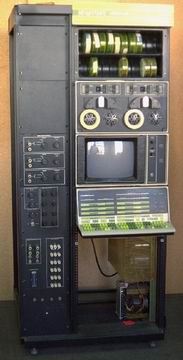 ∇ MY FIRST COMPUTER:
∇ MY FIRST COMPUTER:PDP-12. It was a unique 12-bit machine booting the operating system from a magnetic tape. Due to the lab's scarce budget, it did not have FORTRAN which was the most widely used computer language in universities then. All programs had to be written in the machine language using a toggle switches on the console or better in the assembly language. Program codes were recorded in paper tapes. Rewriting even one line of code, you had to re-punch the whole tape. When I developed a large program, a heap of used paper tapes mounted up. It was such a simple machine from today's standard, that it was suitable for learning computer architecture as well as an assembly language, I think. ∇ MY FIRST BUSINESS COMPUTER: FACOM 230-60. Right after graduating from the university, I found a job as a programmer/system engineer at a data processing center. Fujitsu's flagship mainframe, FACOM 230-60 was the main work force there. 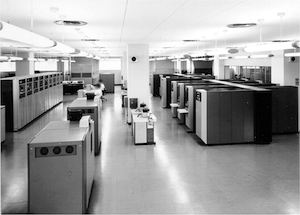 It was an extremely busy post. When a deadline got near, I often worked through the night and into the morning. In spite of the hard work, writing programs for the mainframe was so much fun and I got a lot of knowledge and experience on computers during this period. Looking at the picture of Facom 230-60 (shown left), somebody said "Where is the computer?" Well, time changes. ∇ MY FIRST PERSONAL COMPUTER: NEC PC-8801 mkII (Model 30). I bought it at Marui department store near Fujisawa station. The store clerk offered me a good discount, which was rare in the store. He also said he could have the computer delivered next day, although the next day was Saturday. It sounded such a good deal that I suspected something might be behind it, but bought it anyway. Sure enough, a new model of PC-8801 was announced in a couple of weeks. So what? you might say. Well, PC's product cycle was not as short then as today. 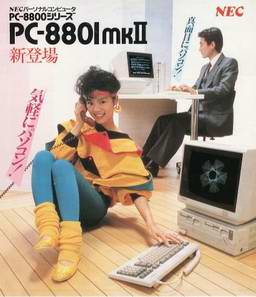 Around that time, ASCII Corp. launched their experimental online service, ASCII Network. The company named the scheme "Compunication", which was a blend of computer and communication, but the word didn't catch on. I bought NEC's 300 bps modem at 50,000 yen (about $650.00) to access the service. Modems those days lacked Network Control Unit and did not dial the number. Because of this reason, acoustic couplers were more widely used. This NEC's state-of-the-art modem was integrated into a telephone set allowing you to switch back and forth between a telephone and modem with a push of the front button. Around that time, ASCII Corp. launched their experimental online service, ASCII Network. The company named the scheme "Compunication", which was a blend of computer and communication, but the word didn't catch on. I bought NEC's 300 bps modem at 50,000 yen (about $650.00) to access the service. Modems those days lacked Network Control Unit and did not dial the number. Because of this reason, acoustic couplers were more widely used. This NEC's state-of-the-art modem was integrated into a telephone set allowing you to switch back and forth between a telephone and modem with a push of the front button.The problem was I had to have NTT technician come to my apartment to hook up the modem. Telephone network was under strict government control. Only NTT certified technicians were allowed to attach or detach any equipment to/from the telephone network. They would charge high fees. Wiring a modem was so simple that anyone could do in a minute, but it would have been illegal. I meant to do it myself but was worried what if they found it and reported to the police. I would have been arrested. I talked with the technician who took care of the telephone network and equipment of the company I worked for. He said,"Nah, it won't be found. If it's found, you just say 'Oh, yeah? I didn't know that' That's it" I got a relief. To connect your computer to an online service, you need not only a modem but also telecommunication software, which was hard to find and very expensive back then. So, I wrote a terminal emulator in BASIC. I still remember the excitement when the program worked and got connected to the remote host. Characters showed up on the screen one by one (because it was only 300 bps). The PC-8801 was an excellent machine. I enjoyed it a lot for programing and playing games, but eventually sold it to my friend when I moved to the U.S. ∇ MY FIRST APPLE COMPUTER: 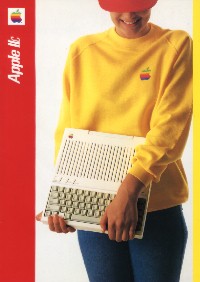 Apple//c. I guess I bought it in 1985 at a computer shop in Akihabara, Tokyo. It was very pricy compared to the Japanese machines of similar specs. I felt I could touch the American culture through it. Application programs for Apple II were also expensive. I asked a friend of mine to buy some pirated software when he went to Hong-Kong. Before I fully enjoyed Apple IIc, I moved to the U.S. I had packed it up securely to ship, but it didn't boot when I received it in New York. I brought it to a computer shop, but their estimate was outrageous. I decided to buy a IIgs, which had been released a year earlier and was a flagship machine of Apple II line. Apple//c. I guess I bought it in 1985 at a computer shop in Akihabara, Tokyo. It was very pricy compared to the Japanese machines of similar specs. I felt I could touch the American culture through it. Application programs for Apple II were also expensive. I asked a friend of mine to buy some pirated software when he went to Hong-Kong. Before I fully enjoyed Apple IIc, I moved to the U.S. I had packed it up securely to ship, but it didn't boot when I received it in New York. I brought it to a computer shop, but their estimate was outrageous. I decided to buy a IIgs, which had been released a year earlier and was a flagship machine of Apple II line.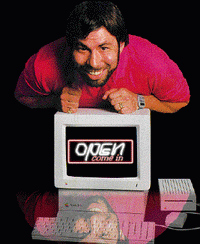 I enjoyed the IIgs for a long time, but was getting dissatisfied with it because of its low screen resolution and lack of Japanese capability. I felt it might be time to switch to Macintosh. I enjoyed the IIgs for a long time, but was getting dissatisfied with it because of its low screen resolution and lack of Japanese capability. I felt it might be time to switch to Macintosh.Apple had already shifted its main focus to Macintosh and was not likely to enhance II line. IIc+ was released after IIgs, but it was never a enhanced model. Especially, its video circuit was less powerful than IIgs. Apple II's market share was diminishing steadily. The most popular Apple II magazine "A+" struggled with declining circulation and was merged with its rival publication "inCider". Yet the magazine became thiner issue by issue. Finally it discontinued leaving July 1993 edition as the final issue. I still keep it as a memento. Having only 48 pages, it looks like a brochure rather than a magazine. Apple II's operating system ceased development at GS/OS 6.01. Come to think of it, Apple II may have been a victim of Apple's Marketing Strategy, which had a different OS platform, Macintosh. If another company had owned Apple II, it would have aggressively kept releasing new models and encouraged software houses to develop business programs. We would have seen trilateral competition today with Apple II, Macintosh, and PC. (My imagination may have gone too far.)  After buying a Macintosh, my computer life gradually shifted to it. IIgs was getting fewer chance to play. One day I decided I should donate it to the children's corner of New York Public Library, rather than leave it under the dust. The Lady working for the library welcomed me with a broad smile and even gave me a thank-you letter. Afterwards, I was pleased to see the IIgs got a new home in the library with kids happily playing around it. ∇ MY FIRST MACINTOSH:  Mac Plus. When I felt IIgs had serious limitation for my needs, Apple released Macintosh SE and lowered the price of Apple Plus. It was now reasonable enough that I could afford it. I went to the Mac Factory, a computer shop in Manhattan, to buy one. After playing it around for a couple of days, I decided that it would not stand to practical use without a hard drive. I bought Mirror Technologies' 33 MegaByte external hard drive at $500. Hard drives were expensive then. I eventually expanded the memory to 4MB and upgraded its operation system to KanjiTalk 6 to make Mac Plus a practical business computer. It helped me with Japanese-English translation works which I started as a side job. With the income from that job, I replaced a slow noisy ImageWriter with a speedy and quiet laser printer, GCC Elite. Mac Plus. When I felt IIgs had serious limitation for my needs, Apple released Macintosh SE and lowered the price of Apple Plus. It was now reasonable enough that I could afford it. I went to the Mac Factory, a computer shop in Manhattan, to buy one. After playing it around for a couple of days, I decided that it would not stand to practical use without a hard drive. I bought Mirror Technologies' 33 MegaByte external hard drive at $500. Hard drives were expensive then. I eventually expanded the memory to 4MB and upgraded its operation system to KanjiTalk 6 to make Mac Plus a practical business computer. It helped me with Japanese-English translation works which I started as a side job. With the income from that job, I replaced a slow noisy ImageWriter with a speedy and quiet laser printer, GCC Elite.When System 7 came out, I bought Mac IIsi with 13 inch Apple color monitor at a clearance sale. Now Mac Plus had given way to IIsi and my macintosh life entered a color age. FrogDesign came to design Macintoshe after SE, which brought Mac's Golden Era. However, early Mac models' (128K - Plus) design by Jerry Manock and Terry Oyama rivals or even surpasses FrogDesign models, I think. Now with no chance to work, my Mac Plus sits quietly in the basement. I still like the design of Mac Plus the most among all Macintosh models. |
|